Wildfire
|
Forest wildfires are a natural part of many of California’s forest ecosystems. Living in the forest or managing forest lands means anticipating and preparing for fire no matter what your management objectives are.
"Because we've invested a lot of resources doing hazard fuel reduction, when the fire did approach, we were prepared for that. The results are staggering...you can go to some property lines, where there property was not treated and that line of demarcation is indeed stark." Joe Smailes, Landowner, Plumas County |
|
Landowner Spotlight
|
JOE SMAILES, Plumas County
How long has your family managed your forest property? 18 years What do you enjoy the most about owning your land? Intrinsic beauty, enjoying a veritable refuge, harvesting forest edible crops, adopting the policy of a hands on treatment for managing the landscape for a variety of uses (especially hazard fuels reduction), What are some of your current goals for your land? Fire resiliency, sustainable timber yield & edible plants. |
Why put in the effort to actively managing your land?
What you put into your land you receive back multi-fold. The satisfaction of work put in is an intrinsic benefit that few would understand - usually reserved for a responsible landowner.
What you put into your land you receive back multi-fold. The satisfaction of work put in is an intrinsic benefit that few would understand - usually reserved for a responsible landowner.
|
FAQ's
How can I protect my home?
Creating defensible space is essential to improve your home’s chance of surviving a wildfire. It’s the buffer you create between a building on your property and the grass, trees, shrubs, or any wildland area that surround it. This space is needed to slow or stop the spread of wildfire and it protects your home from catching fire—either from direct flame contact or radiant heat. Defensible space is also important for the protection of the firefighters defending your home.
Source: Cal Fire what can i do seasonally to reduce the risk of wildfire?
Winter
Spring
Summer
Fall
source: CAL Fire what happens after a wildfire?
Once a forested area has been burned in a wildfire, action by landowners is needed to assess the properties' conditions and whether actions such as replanting are needed. For more information on recovering from wildfire in a forested setting, please see the publication, UC Forest Stewardship Series: Wildfire and Fuel Management or contact your local UC Extension Office or CAL Fire.
|
Resources
|


